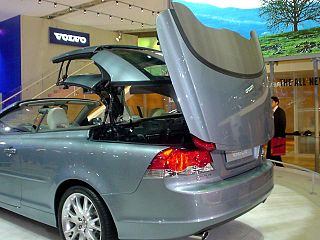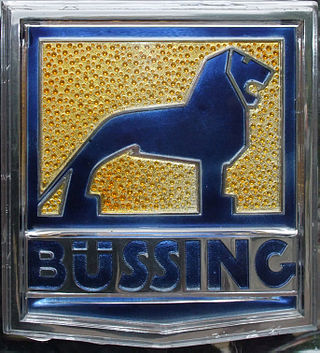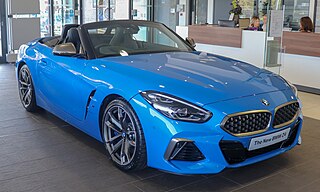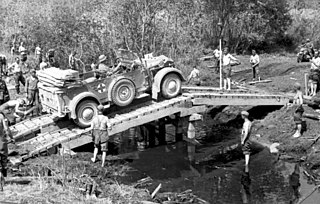
CarlFriedrich Benz was a German engine designer and automotive engineer. His Benz Patent-Motorwagen from 1885 is considered the first practical modern automobile and first car put into series production. He received a patent for the motorcar in 1886, the same year he first publicly drove the Benz Patent-Motorwagen.

Stoewer was a German automobile manufacturer before World War II whose headquarters were in Stettin.

The Chevrolet Corvette is a line of American two-door, two-seater sports cars manufactured and marketed by General Motors under the Chevrolet marque since 1953.

The Volkswagen Karmann Ghia are a family of three overlapping sports car models produced by Volkswagen, marketed in 2+2 coupe (1955–1975) and 2+2 convertible (1957–1975) body styles, though German production ended one year before that in Brazil. Internally designated the Type 14 (1955–1975), the Type 34 (1962–1969), and the Type 145 TC, the Karmann Ghia cars combined the floorpans and mechanicals of the Type 1 / Beetle or Type 3 'ponton' models with styling by Italy's Carrozzeria Ghia, and hand-built bodywork by German coachbuilding house Karmann.
Wilhelm Karmann GmbH, commonly known as Karmann, was a German automobile manufacturer and contract manufacturer based in Osnabrück, Germany. Founded by Wilhelm Karmann in 1901, the company specialised in various automotive roles, including design, production and assembly of components for a wide variety of automobile manufacturers, including Chrysler, Porsche, Mercedes-Benz and Volkswagen Group.

Magna Steyr GmbH & Co KG is an automobile manufacturer based in Graz, Styria, Austria, where its primary manufacturing plant is also located. It is a subsidiary of Canadian-based Magna International and was previously part of the Steyr-Daimler-Puch conglomerate.

The Budd Company was a 20th-century metal fabricator, a major supplier of body components to the automobile industry, and a manufacturer of stainless steel passenger rail cars, airframes, missile and space vehicles, and various defense products.

Erich Bitter Automobil GmbH (Bitter) is a premium sports-luxury automobile marque produced in Germany and later Austria. Founder Erich Bitter (1933-2023), a then retired racing driver turned automobile tuner, importer and ultimately designer began crafting his own vehicles after business ventures with Italian manufacturer Intermeccanica ended.

A retractable hardtop — also known as "coupé convertible" or "coupé cabriolet" — is a car with an automatically operated, self-storing hardtop, as opposed to the folding textile-based roof used by traditional convertible cars.

Siemens & Halske AG was a German electrical engineering company that later became part of Siemens.

The Benz Patent-Motorwagen, built in 1885 by the German Karl Benz, is widely regarded as the first practical modern automobile and was the first car put into production. It was patented in January 1886 and unveiled in public later that year. The original cost of the vehicle was 600 imperial German marks, approximately 150 US dollars.

Büssing AG was a German bus and truck manufacturer, established in 1903 by Heinrich Büssing (1843–1929) in Braunschweig. It quickly evolved to one of the largest European producers, whose utility vehicles with the Brunswick Lion emblem were widely distributed, especially from the 1930s onwards. The company was taken over by MAN AG in 1971.

The XR-400 was a fully operational concept car. A "sporty" youth-oriented convertible was built in 1962 by the Budd Company, an independent body builder in Detroit, Michigan, for evaluation by the fourth largest U.S. automaker at the time, American Motors Corporation (AMC).

The BMW Z models are a line of roadsters manufactured by German automaker BMW. The Z stands for Zukunft, and has been produced in four different series with six generations consisting of roadster, coupé, sports car, and concept variants.

The Präsident was an automobile manufactured by the Nesselsdorfer Wagenbau-Fabriks-Gesellschaft, since 1919 Tatra, in 1897. It was the first practical, factory-produced petrol engine automobile built in Central and Eastern Europe. It was constructed by Leopold Sviták and Hans Ledwinka. The automobile was more of a carriage without horses than a car in modern sense. The car is steered via handlebars. The wooden bodywork is placed on an iron frame. It has four seats and a convertible top that would cover only the rear seats. Both axles have suspension of semi-elliptical leaf springs. The wheels were similar to the ones of a horse carriage, but had rubber tyres. The car had a two cylinder spark ignition Benz engine placed by the rear axle.

Einheits-Pkw der Wehrmacht – literally: "standard passenger motor-car of the Wehrmacht" – was Nazi Germany's plan for a new, multi-purpose fleet of all wheel drive off-road vehicles, based on just three uniform chassis, specifically designed and built for the Wehrmacht. The plan was formulated in 1934, and vehicles were built from 1936 to 1943.

Karosserie Friedrich Rometsch, a German metallurgical-coachbuilding company based in Berlin-Halensee, Nestorstrasse 41, manufactured, modified, and repaired coaches, trailers, bodies and chassis.

Stoewer Sedina is an executive car manufactured by Stoewer automotive company between 1937 and 1940. It has rear-wheel drive with 2.4-litre four-cylinder overhead valve engine and is available in sedan and convertible versions.

Stoewer 10 PS was convertible car manufactured in Stettin, Germany by Stoewer automotive company between 1901 and 1902. It is the first car created by the company. It had a four-wheel drive and 1.5-litre internal combustion engine.

Stoewer Arkona is an executive car manufactured by Stoewer automotive company between 1937 and 1940. It has rear-wheel drive with 2.4-litre four-cylinder overhead valve engine and is available in touring, sedan, convertible, and roadster versions. Together with its sister model, Sedina, it was the last civilian car manufactured by the company.



















